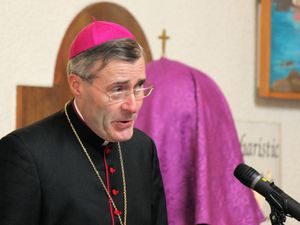Vivid memories of warship attack
It has been 25 years since the day the warship HMS Antelope was bombed and sank during the Falklands War. It has been 25 years since the day the warship HMS Antelope was bombed and sank during the Falklands War. But the memories are still vivid for Keith Davies, of Oswestry, who served aboard the ship at the time. Keith, who is part-owner of The Oswestry Framing Company, is now displaying one of the defining images of the Falklands War - when the frigate he was on exploded - at the shop in Leg Street, Oswestry, to honour the anniversary. HMS Antelope had been deployed on air defence duty on May 23, 1982, at the entrance to San Carlos Water. Read the full story in the Shropshire Star
It has been 25 years since the day the warship HMS Antelope was bombed and sank during the Falklands War.
But the memories are still vivid for Keith Davies, of Oswestry, who served aboard the ship at the time.
Keith, who is part-owner of The Oswestry Framing Company, is now displaying one of the defining images of the Falklands War - when the frigate he was on exploded - at the shop in Leg Street, Oswestry, to honour the anniversary.
HMS Antelope had been deployed on air defence duty on May 23, 1982, at the entrance to San Carlos Water.
Her crew were protecting a beachhead before she came under attack by Argentine A-4 Skyhawk jets.
Two 1,100-pound bombs struck both sides of the warship, instantly killing one crewman.
Mr Davies, who back then was just 17 years old, was the youngest serving Royal Navy crewman in the war.
"At that time Argentine men had to be 21 before they could go to war, so I was the youngest there.
"When we were hit it was just two days before my 18th birthday."
Mr Davies said he returned home a reluctant hero.
"I don't see myself as heroic, just a victim of circumstance," he said.
"I was below decks during fighting and it was pure unimaginable hell.
"We could hear the planes screaming overhead and the roar of guns but we couldn't see any of it. All we could do was huddle in the dark as the planes came in and pray for a quick death.
"It was terrifying. One of the attacking planes crashed into our mast at 400mph and disintegrated.
"The pilot was 1st lieutenant Guadagnini and he died instantly."
After the initial damage had been sustained the ship moved to more sheltered waters so that the Royal Engineers could attempt to defuse the bombs.
A time-delay device detonated the weapon, killing a staff sergeant and severely injuring another.
Mr Davies recalled: "The explosions ruptured the water lines so we were unable to fight the fires effectively and they were soon out of control. We abandoned ship in the dark when the structure started to melt. It was obvious she was lost.
"We were picked up by HMS Fearless and then faced another day of air attacks before being transferred into a North Sea ferry. We sailed out of the exclusion zone under the constant howl of air raid sirens until finally, three days later, we met up with the QE2 at South Georgia to begin our 8,000-mile journey home."
Mr Davies remained in the Royal Navy for a further four years before moving to Oswestry to work as an engineer.
He said: "For many of us veterans, getting home was not the comfort we expected but the beginning of another war. We knew nothing about post-traumatic stress disorder and received no counselling or advice as to how we might feel later on.
"I became very self destructive and depressed."
"Twenty-five-years later I look back at that 17-year-old kid and realise he was suffering because he was afraid of being afraid.
"He thought he was the only one praying for life in the belly of the ship and that this made him a coward. But of course everyone was terrified and the kid, in hindsight did his duty.
"I now have an optimistic and enthusiastic approach to life.
"What happened taught me to live life and I am certainly doing that."
By Antonia Merola



